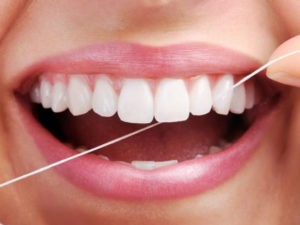
Has your dentist or hygienist ever really shown you how to floss? Daily brushing and flossing keeps your teeth and gums clear of the food and bacteria that breeds gum disease and tooth decay. Following the American Dental Association’s recommendation of brushing at least twice a day and flossing once a day is crucial for good oral health.
You should brush for two minutes, taking care not to brush too aggressively. Brushing your teeth aggressively doesn’t yield better dental health, nor does it remove plaque any better. Flossing properly requires extra effort, but by following the steps provided, you will be doing it perfectly.
Step by Step Instructions on How to Floss
Step 1:
Take 18 inches of floss to 48 inches (at least the length of your arm) of string and twist one to two inches of the ends around the index finger of one hand and the thumb of the other. This ensures you hold the floss with a solid grip. It also will be long enough to cleanse crevices between all of the teeth with a clean section of the string. If you take a longer piece of string, you can wrap it around your hands and direct it with your thumbs and index fingers. Some people prefer to control the string with their middle fingers.
Step 2:
Using a sawing motion, gently slide the the string between two contacting teeth. Remember that there are two surfaces to clean between each tooth contact. Wrap the string in a C shape around one of the two teeth and then the other.
Firmly move the string up and down the sides of the tooth. Do not use a sawing movement after you have broken through the contact. Move toward and below the gum line slightly. Repeat this step, pushing the string against the other tooth. Do not cut into gum tissue.
Step 3:
Floss all of your teeth on both sides. Use a clean section of string between each set of teeth to avoid adding more plaque and food particles to spaces between teeth. To keep track of your progress, always move from one side to the other. For instance, start on your upper left molars and go all the way around to your right molars. Then do the lower arch molar to molar.
Step 4:
After you have flossed all of your teeth, properly brush them and rinse your mouth. Either water or mouthwash will further cleanse your mouth of bacteria and plaque that you flossed from your teeth. Remember to floss before brushing for best results.
Sometimes it is difficult getting the string into the tight spaces between teeth. Try to avoid forcing the string through the spots, as breaking the string can damage gum tissue. If tight contacts between teeth makes flossing challenging, shop for specialized, more durable, waxed versions or dental tape.
The gums will probably bleed if this is a new habit
If you have never flossed before then your gums will not be healthy. Unhealthy gums bleed when touched. They may also be sensitive when the strand goes under the tissue. We recommend that you try to make it bleed. As long as ;you are not cutting the gum from a sawing motion, you will be fine. After several days of firmly applying the string to your gums, the bleeding stops. Your gums are just healing and getting healthy. Healthy gums will be pink in color and will not bleed with flossing or brushing.
Whitening Floss
Today there are numerous types of floss to choose from. Thick, thin, flat, white, colored, roped, waxed, as well as any flavor you can think of. Now whitening versions have been added to the many options. That’s because tooth whitening is a multi billion dollar business. Everyone wants white teeth. Now, in addition to whitening toothpastes and whitening mouthwashes, there is whitening dental floss.
How It Works
Whitening floss doesn’t actually bleach the teeth, but it helps make them look whiter. They are coated with microscopic abrasive silica particles to help remove stains. Others are treated with compounds such as calcium peroxide. Calcium peroxide helps dissolve deposits on your teeth.
Excess proteins can contribute to tooth discoloration. However, what the floss actually does is improve the appearance of your teeth by removing food debris and bacterial plaque to keep your gums healthy. Pink, firm, healthy gums help your teeth look brighter. Teeth, crowns, or implants with severe stains may require professional whitening or dental veneers.
Learn about proper flossing and other oral hygiene techniques
If questions about proper cleaning technique remain, talk to Dr. Fondriest. Discover what dental hygiene products are right for you, and have your mouth cleaning techniques work evaluated at our office. Call (847) 234-0517 to schedule an appointment.
